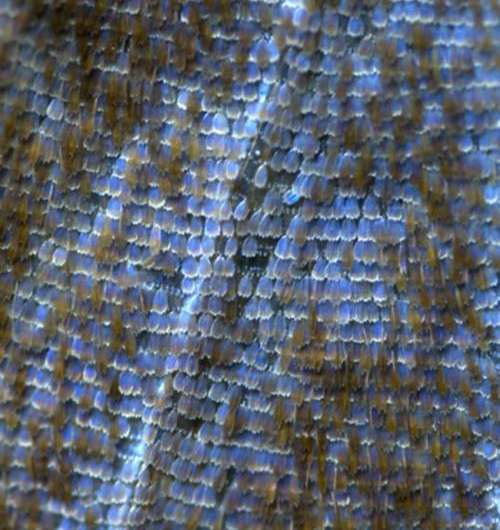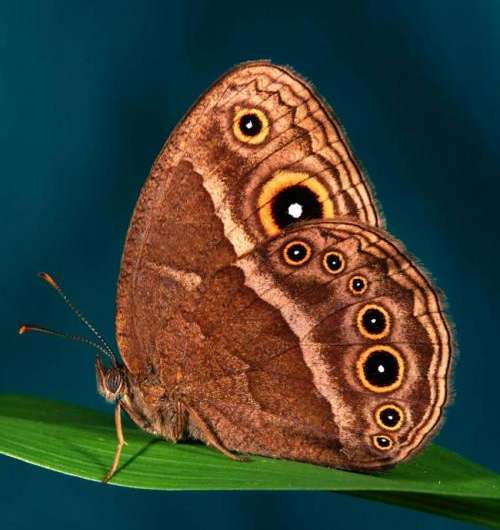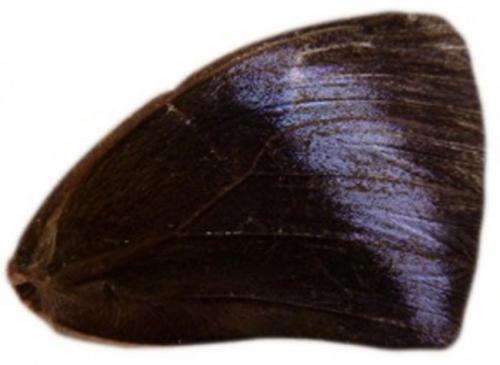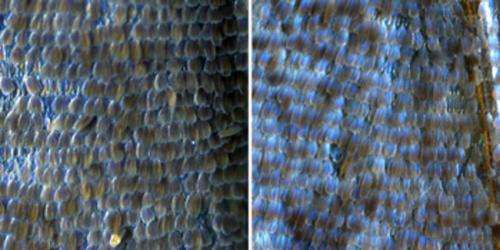August 5, 2014 weblog
Scientists create purple-winged butterflies in six generations

(Phys.org) —Scientists have used selective breeding to create purple wings on the normally brown-winged butterfly Bicyclus anynana. Antonia Monteiro and her colleagues selected butterflies with wing scales that reflected light closest to the wavelengths that produce the color violet and bred them. After six generation of breeding, the researchers produced butterflies with wings that had changed structurally to reflect violet light. The research appears in the Proceedings of the National Academy of Sciences.
Living things can produce color chemically or structurally. Those that produce chemical color create pigments that absorb certain wavelengths of light and reflect others. Organisms that produce structural color experience changes in their bodies, at the nanoscale level, that enhance the reflection of particular wavelengths.
Butterfly wings have structural color. To understand how this color evolves, Monteiro and her team selectively bred B. anynana, a butterfly that normally has brown wings, in an attempt to create purple wings. Two close relatives of this butterfly, B. sambulos and B. medontias, have purple scales on the backs of their front wings. However, until now, no one has ever reported seeing any purple-winged B. anynana.
To create purple wings, the team measured the wavelengths of light reflected from the wings of B. anynana specimens. They then selected and bred those butterflies whose wings reflected light closest to the violet spectrum. They performed this process six times in eight consecutive generations. As the breeding process continued, reflected wavelengths moved further toward the violet spectrum. By the sixth time, the butterflies had purple wings.


Monteiro's team believe their experiment shows that butterfly wing colors can evolve very quickly and that natural selection could play an important role in the development of wing color. For example, butterflies could use wing color to identify other butterflies of the same species or to influence mate choice.

The team says engineers could use these findings when designing devices that tune color, trap light or steer light beams.
More information: Artificial selection for structural color on butterfly wings and comparison with natural evolution, PNAS, Bethany R. Wasik, DOI: 10.1073/pnas.1402770111
Abstract
Brilliant animal colors often are produced from light interacting with intricate nano-morphologies present in biological materials such as butterfly wing scales. Surveys across widely divergent butterfly species have identified multiple mechanisms of structural color production; however, little is known about how these colors evolved. Here, we examine how closely related species and populations of Bicyclus butterflies have evolved violet structural color from brown-pigmented ancestors with UV structural color. We used artificial selection on a laboratory model butterfly, B. anynana, to evolve violet scales from UV brown scales and compared the mechanism of violet color production with that of two other Bicyclus species, Bicyclus sambulos and Bicyclus medontias, which have evolved violet/blue scales independently via natural selection. The UV reflectance peak of B. anynana brown scales shifted to violet over six generations of artificial selection (i.e., in less than 1 y) as the result of an increase in the thickness of the lower lamina in ground scales. Similar scale structures and the same mechanism for producing violet/blue structural colors were found in the other Bicyclus species. This work shows that populations harbor large amounts of standing genetic variation that can lead to rapid evolution of scales' structural color via slight modifications to the scales' physical dimensions.
Journal information: Proceedings of the National Academy of Sciences
© 2014 Phys.org


















